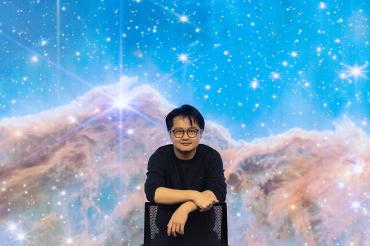‘Something out there’: How a U of T undergrad uses AI to search for aliens

Peter Ma, who is entering his fourth year of study in U of T’s Faculty of Arts & Science, was the lead author on a paper published in Nature Astronomy earlier this year (photo by Johnny Guatto)
Published: July 31, 2023
Is there life beyond our planet? It’s a question that third-year University of Toronto undergraduate student Peter Ma began thinking about when he was still in high school.
A math and physics student entering his fourth year in the Faculty of Arts & Science, Ma is dedicated to searching for aliens – and while that may sound like something out of science fiction, he isn’t exactly chasing down little green men. Instead, he’s drawing on his passion for science to find the data that could prove we’re not alone in the universe.
Ma was in Grade 12 when he wrote an algorithm to look for signs of intelligent life using open-source data from the University of California, Berkeley and its Breakthrough Listen research program.
After cold-emailing researchers at the SETI Institute, he became the youngest member of the team of international researchers at UC Berkeley dedicated to the search for extraterrestrial intelligence, and was lead author on a paper published earlier this year in the journal Nature Astronomy.
“I was super-curious even as a really young kid,” says Ma, who grew up in a Chinese-speaking household and learned English by reading books borrowed during visits to the local library.
“I remember asking my parents questions about everything as early as age four – and they didn’t really know how to answer most of them.”
Ma recalls getting a telescope at age six, and frequent trips to Home Depot and Walmart to buy supplies for his many “on steroids” science projects. One such challenge to build a working chair for the school principal out of recycled materials found Ma toying with the idea of melting aluminum cans – until he realized it was “probably not a good idea to build a furnace in the backyard.”
In high school, he taught himself Grade 11 computer science in three weeks, spending the remainder of the semester devouring videos on machine learning and deep learning – eventually developing his space-scanning algorithm using Breakthrough Listen’s open-source data.
“I was looking for interesting problems to solve,” he says, recalling how his high school teachers were more perplexed than impressed with his AI exploits.
Even while stuck at home during the pandemic, Ma managed to maintain that momentum, working with SETI in the summer before starting university as a member of Victoria College. Once his classes were underway, he continued the collaboration with the support of the Laidlaw Scholars Program.
Using his algorithm, Ma and the SETI team detected eight radio signals that may have originated from life on another planet – when he relayed the findings to his U of T supervisors, he was surprised to hear them suggest the study could be published.
“When they said, ‘We’re going to send this to Nature Astronomy,’ I thought, ‘Wow, hold on – I’m not ready for papers.’ Usually those are done by actual researchers – in comparison to them, I’m still learning my ABCs.”
Ma stresses that when SETI refers to signals coming from an alien civilization, they aren’t necessarily talking about the big-eyed creatures we see in movies – but rather signs that point to some kind of life well beyond our own planet.
“We obviously can't search for intelligence per se – we search for proxies of the targets. So, we search for signs of engineering – in this case, engineering of radio technosignatures, or radio emissions. We believe that intelligent species can produce technology – a phone or a telescope or something like that – and we detect those kinds of signals.”
Ma credits his U of T supervisors and collaborators – in particular study co-author Cherry Ng, a former research associate at the Dunlap Institute for Astronomy and Astrophysics, jointly affiliated with SETI, who is now an astronomer at the Centre National de la Recherche Scientifique in France; and Bryan Gaensler, director of the Dunlap Institute and professor in the David A. Dunlap department of astronomy – for preparing him to work alongside veteran researchers in the field.
“Peter is self-motivated and not afraid of challenges,” says Ng, who began working with Ma in the summer of 2020 to search for technosignatures using the Green Bank Telescope based in West Virginia.
“When we get stuck on the analysis, instead of giving up, Peter would always come up with new ideas to try again. It’s his determination that sets him apart.”
Ma and the SETI team plan to continue their work with a two-year project that will scan up to one million stars (Ma’s paper, by contrast, looked at just 820 stars) using a set of 64 telescopes in South Africa.
Ma will have graduated from U of T by the time the project wraps up, but unsurprisingly plans to continue his scientific exploration as a graduate student.
“There has never been a better time in history to find extraterrestrial life now and in the future – our probability of actually finding them only goes up from here,” says Ma, who is spending his summer working with the experimental particle physics group at McGill University on a joint project with CERN, the Swiss-based organization that developed the Large Hadron Collider.
“If you truly believe that we’re alone here [in the universe], then that’s a different story. But if you believe that there’s something out there, then it’s only a matter of time until we actually find it.”



